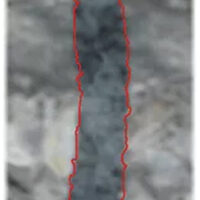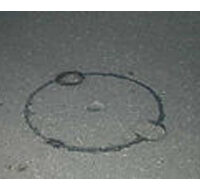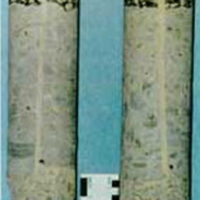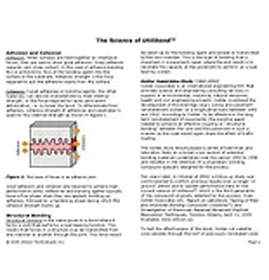Utilibond Testing
Golder Associates Study (1992-2002)
Golder Associates is an international engineering firm that provides science and engineering consulting services in support of environmental, industrial, natural resources, health and civil engineering projects. Golder monitored the development of the Enbrid/ge rotary coring and pavement reinstatement system on a longitudinal basis between 1992 and 2002. According to Golder, to be effective in the long term reinstatement of pavements, the bonding agent needed to achieve an effective coupling or “structural bonding” between the core and the pavement in such a manner as the road would again share the effect of traffic loading.
The Golder study encompassed a series of field trials and laboratory tests on a broad cross section of potential bonding materials undertaken over the period 1992 to 1996 and resulted in the selection of a proprietary bonding compound specially designed for the process. Ten years later, in October of 2002, a follow up study was commissioned to confirm previous results over a longer “in ground” period and to update performance data on the current version of Utilibond™ which is the third generation of the compound originally selected for the process.
To test the effectiveness of the bond, Golder cut satellite core samples (as seen to the right) through the kerf of
previously reinstated core. These samples showed perfect and complete bonding or adhesion of the Utilibond to
both the surface of the core or coupon and the surface of the remaining pavement as well as excellent “cohesion”
through the joint itself.
The Golder study is the only ten-year longitudinal study to evaluate the effectiveness of a road reinstatement process
by monitoring the degree of coupling between the undisturbed road structure and the newly restored utility cut. It concluded that: “The lab trials and previous demonstrations on the rotary cutting method have shown that the pavement coupon has been bonded into the slab in such a manner that the loads of traffic are effectively transmitted to the remaining intact slab. Based on trials carried out at our testing laboratory in Whitby and our in-field performance observations, we are satisfied that the equipment, procedures and materials [including Utilibond™] developed and used by Enbridge Gas Distribution over the last 10 years will ensure satisfactory long term performance of pavement reinstatement.”
Top right picture: Satellite core samples taken through bonded area of reinstated core.
Bottom right picture: The light gray line is Utilibond showing excellent bonding of asphalt-concrete core (central area) and undisturbed pavement (outer layer) with complete infilling of voids in peagravel (bottom).
The Mechanics of Bonding:
Department of Civil Engineering University of Illinois: Prof. David Lange* (2003)
According to Prof. David Lange from the Department of Civil Engineering University of illinois, the mechanical performance of the bonding material is the most important factor in achieving long-term performance in the reinstatement of cores in pavement. It is well known that repair or bonding materials achieve their primary bond through mechanical interlock with the surface or microstructure of the substrate. It is important that the bonding material mechanically engage with the surface irregularities or penetrate the pore structure of the concrete.
To be effective, the solid particulate in a dry-base bonding agent needs to be fine enough, when mixed with water, to establish an intimate bond with the surfaces to be bonded. Coarser grouts will not work as well and, while they may exhibit good compressive strength or appear able to fill the kerf and stabilize the core, they will lack the adhesive qualities of a good bonding agent. Traffic pressure and vibration may cause premature adhesive bond failure in these grouts that will deprive the joint of vertical support and the ability to transfer transverse loading across the joint, as well as permitting the infiltration of water into the subgrade.
When liquefied by the addition of water, the chemical composition and fine granular structure of Utilibond results in a lower surface tension of the bonding material relative to the solid surfaces of the concrete substrate. Surface tension is the force at the surface of a liquid due to adhesive forces of the liquid molecules for the solid walls of a container (in this case the surface of the core and the surrounding pavement) and the attractive forces of the molecules of liquid for each other. When the adhesive forces of the molecules for the solid walls are greater than the attractive forces between the liquid molecules, then the liquid will wet the solid surface. In porous solids like cement paste, concrete or asphalt, the liquid will wet the exposed surfaces and will be drawn into intimate proximity with the surface structure (densification) under forces known as capillary tension. The extent of penetration of a liquid into pore structure which contributes to densification is governed by the strength of capillary tension forces and the liquid viscosity.
Unlike Utilibond, which is a bonding agent, in typical grouts these forces are very weak or non-existent. The relationship of viscosity with time is one way of understanding the evolution of Utilibond from a liquid to a solid. As a liquid with a low viscosity it can wet the concrete surface and be drawn into very close contact with the concrete pore structure by capillary forces. The densification process of Utilibond will cease when the material hydrates.
Bond Microstructure: An examination of the microstructure illustrated in the picture to the right shows the interface between Utilibond and the concrete substrate of the core and the surrounding pavement shows a very strong and high quality adhesive and cohesive bond.

Gas Technology Institute:
“No Bottom” Keyhole Core Reinstatement Test (2003)
The strength of the core bond was demonstrated in the “no bottom” experiments of the Gas Technology Institute conducted in the Fall of 2003. GTI “No Bottom” Core Test (2003). In this test, using Utilibond for the core reinstatement, GTI restored a cored hole without backfill. The original GTI study plan was to demonstrate the effectiveness of backfill compaction as a factor in keyhole reinstatement. They planned to use various levels of compaction: good / fair / poor / no backfill at all.
False bottom hole constructed

Utilibond poured into hole and core reinstated

10,000 lbs. loading machine with over 40,000 passes over reinstated core

GTI started with the no backfill experiment in which they cored and vacuumed an 8 inch deep hole in asphalt, inserted a temporary false bottom consisting of a cardboard plate suspended by strings on to which they placed pea gravel and then Utilibond and reinstated the core. After the Utilibond set they released the string supports of the false bottom and began testing the ability of the Utilibond to support a suspended core — with no backfill under it.
To do this they passed their 9,000 lb AASHTO standard test vehicle over the core and to their surprise it sustained more than 40,000 passes before giving way and settling about 20 millimeters on one side. As some of the failure appears to have occurred in the asphalt outside the bond and the Utilibond layer in that area remained intact, the technicians were unable to determine whether or not it was failure of the asphalt around the core that occurred first, there being no bridging strength in asphalt, causing undue torque on the core that then caused the failure in the bond, or whether it was failure of some areas of the kerf that may not have been fully impregnated with bonding agent when the core was originally set into the hole. For obvious reasons, when reinserting the core, the technicians were reluctant to aggressively manipulate the core (as would have been done to distribute the Utilibond in a normal reinstatement) for fear of destroying the false bottom. Although the test may have been compromised by possible defects in the actual reinstatement procedures, and the actual cause and effect of the failure speculative, the experiment did prove that Utilibond was more than just a grout that infills the kerf of the core like a traditional grout.
Utilibond is, as designed and engineered, a Pavement Bonding Compound. The GTI test demonstrated that Utilibond had significant adhesive and cohesive bonding strength to support an otherwise unsupported 8 inch core of asphalt exposed to more than 40,000 passes of the 9000 lb. AASHTO standard test vehicle in which the wheel path passed directly over the core. That is equivalent to more than seven years of traffic on a non-arterial road. This test also tends to support anecdotal evidence of Utilibond reinstated cores withstanding underground washouts that undermined the entire pavement area resulting in a sinkhole. Notwithstanding the long-term lack of support resulting in catastrophic sub-surface failure, the Utilibond reinstated core demonstrated no deflection from the surrounding pavement layer whatsoever.
National Research Council of Canada and U.S. Army Corps of Engineers:
Restoration of Utility Cuts Study (2005) / Field Investigation, Toronto Site
The “Restoration of Utility Cuts” project is a joint effort involving a number of North American cities, utility companies and U.S. State departments of transportation. The objective of the project was to develop a guide for best restoration practices based on sound engineering principles. As part of this study an experiment was conducted in Toronto using two cut sections — a conventional transverse trench and a keyhole. The report, scheduled to be released in June 2005, discusses results of in-situ testing and data collected from sensors installed in the restored cuts covering a wide range of engineering parameters and environmental conditions. In situ tests covered quality control tests included in City specifications. Sensor data was collected in four visits to the site where a test truck and the FWD device were used to load the test sections.
Road condition data collected prior to construction was used to establish a reference for tracing changes associated with cutting (trench vs. keyhole) and quality of construction. After the reinstatement, damage survey visits and inspections were conducted on three occasions. Observations made during these site visits noted that: ‘There were noticeable failures in the conventional cut… The conventionally repaired joint between the road and the cut opened. The location of this joint separation coincided with visible settlement in the trench along the wheel path. The material used to seal the joint was lost under the action of traffic as a result of shear flow or pullout of the sealant and there are indications that the sand cover and surrounding clay in the Toronto restored cut were exposed to higher than normal levels of moisture (compared with the keyhole).”
Observations of the reinstated keyhole:
- No infiltration of ground water
- There were no defects noted in the keyhole cut
- There is no deflection or settlement of the reinstated core
- The surface of the restored keyhole remained at level with the road profile
- The Utilibond surrounding the AC/PCC plug remained intact (no cracking or separation)
- The keyhole section established on October 2001 continued to perform well throughout the life of the experiment
In conclusion, the study reported that “The combination of keyhole construction technique and unshrinkable fill produced an effective restoration technique that should be encouraged whenever feasible to minimize the need for opening large trenches in the future, and confirms that the keyhole excavation and reinstatement method using Utilibond is superior to conventional utility cut repair methods.”
The Science of Utilibond (2005)
Adhesion: When surfaces are held together by interfacial forces, they are said to show good adhesion. Good adhesion requires very close contact. In the case of adhesive bonding this is achieved by flow of the bonding agent into the surface of the substrate. Adhesion strength is the force required to pull the adhesive clearly from the surface.
Cohesion: Cured adhesives or bonding agents, like other materials, can also be characterized by their internal strength, or the force required to cause permanent deformation, i.e. to break the bond.
To differentiate from adhesion, cohesive strength of adhesives and substrates is used for this internal strength. Good adhesion and cohesion are required to achieve high performance joints. Adhesives and bonding agents typically have a flow phase when they are applied, building up adhesion, followed by a hardening phase during which the cohesive strength builds up.
Structural Bonding:
Structural bonding is the name given to a bond where it forms a joint that performs a load bearing function. This means that forces in a structure may be transmitted from one member to another through the joint. This force would be taken up by the bonding agent and spread or transmitted to the next member. This is the type of bonding that is important in a pavement repair where the end result is to reinstate the capacity of the pavement to perform as a load bearing system.
The successful adhesive and cohesive bonding performance of Utilibond in these tests is due both to the fineness of its granular structure and proprietary additives that contribute to lower surface tension when in liquid form and accelerated strength gain during hydration.
When initially mixed, Utilibond has a low viscosity and a low surface tension that allows capillary forces to draw it very close to the surface structure of the concrete and fully engage the underlying substrate where its very high density and super-fast strength gain result in a very strong bond capable of supporting 52,600 lbs in less than 30 minutes. When used for reinstatement of cores, these properties result in a waterproof joint that reintegrates the core with the roadway to restore the structural performance of the original roadway as a load bearing system.
CTL Group:
ASTM Bond Strength Test Results (2009)
In 2009, Construction Technology Labratories (CTL) tested Utilibond using the following ASTM tests:
- ASTM C 109/C 109M-08, “Standard Test method for Compressive Strength of Hydrualic Cement Mortars”
- ASTM C 882/C 882M – 05e1, “Standard Test Method for Bond Strength of Epoxy-Resin Systems Used With Concrete By Slant Shear”
- Modified ASTM C 157/C 157M-06, “Standard test Method for Length Change of Hardened Hydrualic-Cement Mortar and Concrete
- ASTM C 1437-07, “Standard Test Method for Flow of Hydraulic Cement Mortar”
- Modified ASTM C 672/C 672M-03 ” Standard Test Method for Scaling Resistance of Concrete Surfaces Exposed to Deicing Chemicals
The final results indicate that Utilibond meets R2 classification of compressive strength, bond strength, length change, consistency, and scaling resistance requirements of ASTM C 928/c-05 “Standard Specifications for Packaged, Dry, Rapid-Hardening Cementitious Materials for Concrete Repairs.”
CTL Group found that ” The fracture pattern indicates the bond material is stronger than the sub-straight material”, which means the Utilibond bond is actually stronger than the pavement itself.
David A. Lange, Ph.D., P.E., FACI, is a recognized authority inthe area of civil engineering materials, cement microstructurepropertyrelationships, fracture mechanics of concrete, fiberreinforced concrete, and interfacial bond in cement-based andmasonry materials. He is the Principal Investigator or Co-PrincipalInvestigator for the Illinois Department of Transportation, TheNational Science Foundation, Master Builders, Inc., AppliedSciences, Inc., Federal Aviation Administration, FAA Center ofExcellence, and the NSF Center for Advanced Cement BasedMaterials. Dr. Lange also serves as the Chairman of the CementsDivision of the American Ceramic Society, Chair of ACI Committeeon the “Materials Science of Concrete,” and is Associate Editor ofthe ASCE Journal of Materials in Civil Engineering.








